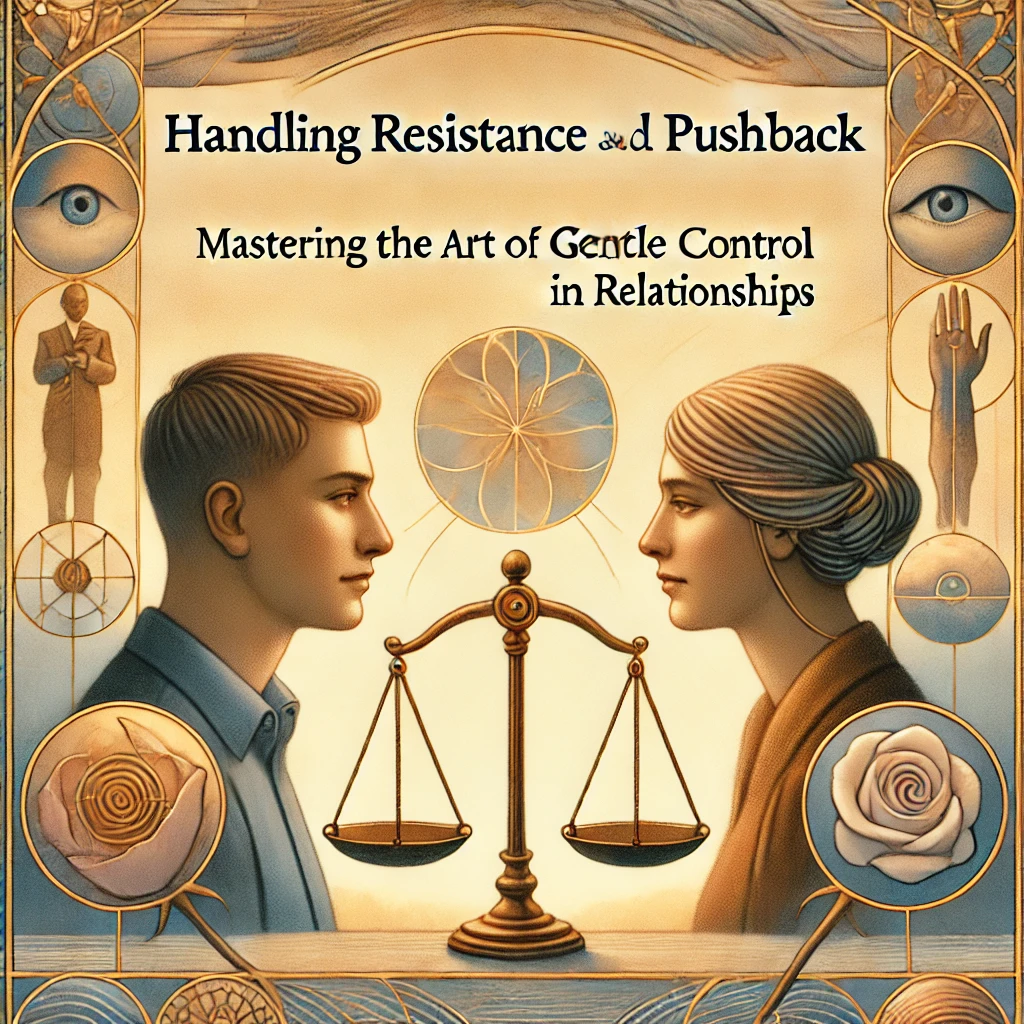Let’s be real—every relationship hits those moments when one partner pushes back against the other’s ideas, preferences, or desires. It’s a natural part of the dynamic between two individuals who each bring their own wants and needs into the relationship. But what if I told you that handling this resistance and pushback effectively isn’t about confrontation or giving up on your goals? Instead, it’s about mastering the art of gentle persuasion, guiding your partner without triggering defensiveness. That’s exactly what Chapter 7 of “Mastering Him: The Secret Art of Gentle Control in Relationships” covers in depth—how to skillfully manage resistance and subtly influence your partner toward your desired outcome.
If you’ve ever found yourself frustrated by your partner’s resistance, this chapter will be an eye-opener. It teaches you how to decode their objections, understand where the resistance is coming from, and use that knowledge to guide them in a way that feels collaborative rather than controlling. It’s about finding that balance between respecting their autonomy while still getting the outcome you’re after—without turning every disagreement into a power struggle.
Why Resistance Happens in Relationships
Let’s start by acknowledging a simple truth: resistance is normal. It’s a part of every relationship. Resistance can arise for any number of reasons—fear of change, insecurity, or a desire to maintain control. Often, it’s not even about the specific issue at hand. Your partner might push back because they feel uncertain or vulnerable, or because they don’t like feeling pressured.
The key to handling resistance is to realize that it’s not a sign of failure—it’s an opportunity to deepen your connection by understanding your partner’s perspective. Chapter 7 emphasizes that the first step in overcoming resistance is empathy. You have to understand the root of the pushback before you can address it effectively.
The Subtle Art of Handling Pushback: What Chapter 7 Teaches
So, how do you deal with resistance without escalating tensions or getting stuck in a frustrating stalemate? Here’s a sneak peek into some of the strategies covered in Chapter 7.
1. Acknowledge the Resistance Without Confrontation
One of the worst things you can do when you’re met with resistance is to ignore it or bulldoze over your partner’s objections. Instead, acknowledge their feelings. A simple phrase like, “I see where you’re coming from,” can go a long way in diffusing the situation and showing that you respect their point of view.
When your partner feels heard, they’re more likely to open up and explain the reasons behind their pushback. This gives you valuable insight into their thought process and allows you to approach the situation from a place of understanding rather than confrontation.
Example:
Let’s say you want to make a major purchase—a new car, for example—but your partner resists. Instead of saying, “We need this car,” you could say, “I understand that this is a big decision, and you’re concerned about the cost. Let’s talk through those concerns.” You’re acknowledging their resistance while still keeping the conversation open for negotiation.
2. Use the Power of Questions
Another brilliant strategy in handling pushback is to use the power of questions to shift the dynamic. Instead of making statements or trying to argue your point, ask open-ended questions that guide your partner toward seeing the situation from your perspective. This is a classic influence technique that turns the conversation into a collaborative effort.
Example:
If your partner is resistant to an idea, you could ask, “What’s your biggest concern about this decision? How can we work together to address it?” This puts you on the same team, tackling the issue together instead of framing the conversation as a conflict where one person has to win.
Chapter 7 dives deep into how to frame these questions effectively, steering the conversation without your partner feeling manipulated. It’s about planting seeds of thought that they can reflect on, rather than trying to force an outcome.
3. Mirror Their Concerns—Then Gently Shift
Mirroring is another technique discussed in the book that helps to disarm your partner’s defenses. By reflecting their concerns, you show empathy, which makes them feel validated. Then, after you’ve mirrored their thoughts, you can slowly start to guide the conversation toward a solution that aligns with your own goals.
Example:
Let’s say your partner is pushing back on the idea of moving to a new city. You could say, “I understand that moving is a big change, and I know you’re worried about leaving behind friends and family. It’s a huge decision. But what if we think about all the opportunities this move could bring, too? We can find ways to stay connected with everyone we love, and at the same time, create new experiences together.”
This approach balances acknowledgment with gentle persuasion, making your partner feel less like they’re being forced into something and more like they’re exploring possibilities.
4. Find the Hidden “Yes”
One of the most provocative ideas in Chapter 7 is the notion that every “no” hides a potential “yes.” Often, resistance isn’t about rejecting your idea outright; it’s about an unspoken need that hasn’t been addressed. Your job is to find the hidden “yes” behind your partner’s objections.
Maybe your partner’s pushback about a vacation plan is really about feeling overwhelmed with work. Maybe their resistance to your financial suggestion stems from anxiety about future stability. Whatever the hidden reason, once you uncover it, you can address it and make it easier for your partner to come on board with your plan.
Example:
If your partner is resistant to a new financial investment, instead of focusing solely on the investment itself, explore their underlying concerns: “I’m sensing you’re worried about the risks involved with this. How can we find a way to feel more secure about this decision?”
By addressing the root cause of their hesitation, you’re more likely to move the conversation forward in a productive way, rather than hitting a wall.
Why Handling Resistance Matters in Long-Term Relationships
Here’s where things get controversial: the way you handle resistance can make or break your relationship. If you let every instance of pushback turn into a battle of wills, you’ll end up in a constant power struggle. But if you learn how to handle it with grace, understanding, and subtle influence, you create a relationship dynamic where both partners feel heard, respected, and valued.
The truth is, you can guide your partner without them realizing it. And no, it’s not manipulation—it’s about understanding the psychology behind resistance and using it to foster a deeper connection. After all, the goal isn’t to win every disagreement, but to create a relationship where both of you feel empowered and aligned.
Q&A:
- How do I handle resistance from my partner without starting an argument?
Acknowledge their concerns without dismissing them, using empathetic language and open-ended questions to understand their perspective before suggesting solutions. - Why does my partner always push back on my suggestions?
Resistance can stem from insecurity, fear of change, or feeling pressured. Recognizing these reasons helps address the root cause rather than reacting to the surface objection. - What are effective ways to gently persuade my partner?
Techniques like mirroring their concerns, using positive framing, and asking guiding questions can help them see your perspective without feeling controlled. - How can I get my partner to agree with me without being manipulative?
The key is empathy and collaboration—engage in conversations that highlight shared goals and explore their concerns openly to find a balanced approach. - What should I do if my partner resists big decisions like moving or finances?
Use the “hidden yes” technique by exploring what underlying concerns they have about the decision and addressing those fears directly. - How can questions help in overcoming relationship resistance?
Open-ended questions shift the focus to collaborative problem-solving, allowing both partners to discuss their concerns constructively rather than defensively. - Why does handling resistance matter in long-term relationships?
Managing resistance gracefully prevents constant power struggles, fostering a healthy dynamic where both partners feel heard and respected. - How can I use mirroring to deal with my partner’s objections?
Reflect their concerns back to them to show understanding before gently introducing your own perspective. This approach reduces defensiveness. - What is the “hidden yes” behind a partner’s resistance?
It’s the unspoken need or concern behind a “no.” Discovering this can reveal the underlying reasons for resistance, making it easier to address collaboratively. - Is it possible to guide my partner’s decisions without causing conflict?
Yes, with techniques like empathy, understanding, and subtle influence, you can encourage their openness to new ideas without making them feel pressured.
Ready to Master the Art of Gentle Control in Your Relationship?
If you’re intrigued by the ideas we’ve discussed here, then “Mastering Him: The Secret Art of Gentle Control in Relationships” is your next must-read. Chapter 7 offers a deep dive into handling resistance, along with practical techniques that will change how you navigate pushback in your relationship forever.
This isn’t just another relationship book—it’s a manual for mastering influence in a way that feels empowering, not controlling. You’ll learn how to subtly guide your partner, avoid conflict, and create a relationship where both of you feel like you’re winning.
Get your copy today and start mastering the art of gentle control in your relationship. It’s time to turn resistance into connection and lead your relationship in the direction you want—without the power struggles.
Read more about the book: https://developmentpill.com/mastering-him-the-secret-art-of-gentle-control-in-relationships-a-guide-to-influence-hell-never-see-coming/
Book Link: https://www.amazon.com/dp/B0DKKGLZQ9
Book Link UK: https://www.amazon.co.uk/dp/B0DKKGLZQ9
You can find book Links for other regions in this post page: https://developmentpill.com/mastering-him-the-secret-art-of-gentle-control-in-relationships-a-guide-to-influence-hell-never-see-coming/



